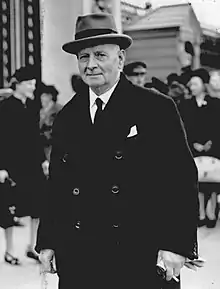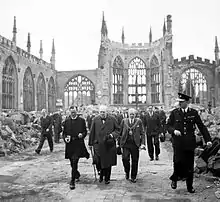Alfred Robert Grindlay
The Right Worshipful, The Mayor of Coventry, Alderman (ex officio) Alfred Robert Grindlay CBE, JP (1 February 1876 - 14 April 1965) was an English inventor, industrialist and official during the 19th and 20th centuries. He co-founded Grindlay Peerless, the motorcycle engineering company and was mayor of Coventry during WWII and the Coventry Blitz.[1][2][3][4]
Alfred Robert Grindlay CBE JP | |
|---|---|
 A R Grindlay outside Buckingham Palace, 20 May 1947 | |
| Mayor of Coventry | |
| In office 01 January 1941 – 31 December 1941 | |
| Councillor for Coventry City Council | |
| In office 1923 – 1962 (39 years) | |
| Personal details | |
| Born | 1 February 1876 Coventry, Warwickshire |
| Died | 14 April 1965 (aged 89) Coventry, Warwickshire |
| Nationality | British |
| Spouse(s) | Emma Chaplin (m.1896) |
| Children |
|
| Mother | Mary Ann Raby |
| Father | William Vaughan Grindlay |
| Occupation |
|
| Awards |
|
Early life
Grindlay was born in Coventry, England in 1876, the fifth child of nine and second son of William Vaughan Grindlay (1843-1891), into a family of established engineers and horological master craftsmen.[5] Upon leaving school, Grindlay joined a local cycle firm and began learning the skills he would employ later in his career.[3]
At the age of 20, Grindlay married Emma Chaplin in St Paul's Church, Coventry on the 7th of September 1896, starting his family in 1899 when the first of his two sons was born.[6]
By 1901, Grindlay was working at Riley Cycle Company, one of the major firms in Coventry at that time. Grindlay progressed steadily within the company, until 1911, while working as a foreman at Riley Cycle Company, he applied for a patent (24,683) regarding 'improved means for carrying spare wheels' for motorcars. That same year Grindlay left Riley Cycle Company and took over the Coventry Motor & Sundries business, establishing Grindlay Sidecars, which became known for its "extremely high quality" machines.[7][8]
During WWI he combined forces with Thomas Edward Musson (b.1875) founding Musson & Grindlay, specialising in Sidecar production. Grindlay oversaw Musson & Grindlay and Coventry Motor & Sundries provide key materials for the armament and munitions industry in Coventry throughout WWI.[9] However, parting ways with Musson in 1923, Grindlay established Grindlay Peerless. Grindlay further expanded his manufacturing operations in 1939 when he formed Coventry Engineering Company.[10][11]
Motor industry
Formed in 1923, Grindlay Peerless operated out of Melbourne Works on Shakleton Road in Spon End, Coventry, entered into the wider motorcycle market in the early 1920s and began making high-powered machines. Like the Grindlay Sidecars before them, employed technological advances and innovative engineering, which included utilising early aircraft design features.[8][12]
CWG 'Bill' Lacey became the first man to exceed a 100 miles in an hour on British soil in August 1928 aboard his modified 498cc Grindlay Peerless.[13] The bike covered 103.9 miles in the hour at Brooklands racing circuit, in Surrey to secure a Fédération Internationale de Motocyclisme (FIM) world record.
In 1929, Bill Lacey broke the record again on his Grindlay Peerless, by covering 105.78 miles in the hour at Autodrome deLinas-Montlhéry, Montlhéry, in France.[14]
Government

Grindlay was a prominent member of Coventry City Council. Joining the council in 1923, he dedicated much of his life local government in Coventry and wider Warwickshire.
During WWII, in 1941, Grindlay was appointed Mayor of Coventry (later styled Lord Mayor) and presided over Coventry during the Coventry Blitz that saw 230 bombers attack the city, dropping 315 tons of high explosive and 25,000 incendiaries during the April 1941 attack. Grindlay led much of the early work to rebuild the city following the 1941 bombing and a large portion of the city owes its design origins to his directives.[1]
On the 14th of October 1942, in response to the war-time solidarity that had developed between the people of Coventry and Stalingrad (now Volgograd), in a telegram to the people of Stalingrad, Grindlay wrote:
"The inhabitants of Coventry will never forget the sacrifices which were endured by Stalingrad. They express to you, the people of Stalingrad, their feelings of special sympathy and admiration for your great courage and iron determination to fight until victory."[15]
This close war-time relationship, fostered by Grindlay and the citizens of Coventry, resulted in the twinning of the two cities in 1944, becoming sister cities. This act of comradeship started a trend that would spread across Europe and the rest of the world.[16]
Grindlay House in Windsor Street was named so in his honour.[17]
Public honours
In 1943, Grindlay was made an Officer of the Order of the British Empire (OBE) for his work as Chairman of the Coventry Saving Committee and Chairman of the City Redevelopment Committee.[17][18]
Three years later in 1946 he was made a Commander of the Order of the British Empire (CBE) for his service to the nation and personally commended for his efforts by King George VI. The formal investiture took place on Tuesday the 20th of May 1947 at Buckingham Palace.[2][3]
Later life
Having been a Coventry City Councillor for nearly 39 years, Grindlay was awarded the Freedom of the City on 15 November 1962.[4][19] His award is described by Coventry City Council as being "in recognition of his eminent and devoted service to the city during a period of unprecedented municipal development and as a token of public esteem".[4]
Grindlay died in Coventry in 1965 aged 89 years, [20] and is remembered as "the "Father" of Coventry City Council".[21]
See also
- Grindlay family
- Grindlay Peerless
- List of Grindlay Peerless people
- Derwent Island House, one of a number of residences of the Grindlay family during the 20th century.[21]
- History of Coventry
- Coventry Blitz
- Grindlays Bank
Notes
- "www.historiccoventry.co.uk".
- McGrory, David. Coventry's Blitz. Amberley Publishing Limited.
- Kimberley, Damien (2012). Coventry's Motorcar Heritage. History Press Limited.
- "www.coventry.gov.uk". Archived from the original on 2015-10-04.
- Warwickshire County Record Office; Warwick, England; Warwickshire Anglican Registers; Roll: Engl/2/1234; Document Reference: DR 411. Warwickshire Anglican Registers. Warwick, England: Warwickshire County Record Office.
- "Foleshill St Paul Marriages 1886 - 1902" (PDF).
- "Grace's Guide to British Industrial History". Grace's Guide.
Section: Grindlay-Peerless
- Jackson, Colin (2013). Classic British Motorcycles. Fonthill Media.
- Anthony Batchelor, Laurence (2008). A GREAT MUNITIONS CENTRE: COVENTRY’S ARMAMENTS & MUNITIONS INDUSTRY 1914 – 1918 (PDF). Department of Geography, Faculty of Business, Environment and Society Coventry University.
- "Grace's Guide to British Industrial History". Grace's Guide.
Section: Alfred Robert Grindlay
- Directory of Coventry Manufacturers (PDF). England: The Public Relations Department of the Corporation of Coventry Municipal Information Bureau. 1936. pp. 33, 35, 43.
Coventry Motor Sundries Company Ltd (Est. 1910) p35; Grindlay Company (Est. 1918) p43; Coventry Engineering Company Ltd (Est. 1936) p33
- "www.realclassic.co.uk". Archived from the original on 2013-05-27.
- "www.bonhams.com".
- "VMCC Warwickshire (Extract)" (PDF).
- "www.talkingbirds.co.uk".
- "www.coventrytelegraph.net".
- Gould, Jeremy. The Architecture of the Plan for Coventry (1940 to 1978). Jeremy and Carline Gould Architects.
- "www.thegazette.co.uk".
- "The National Archives".
- "Roots Web".
- "The British Newspaper Archive". Coventry Evening Telegraph. 21 April 1965.